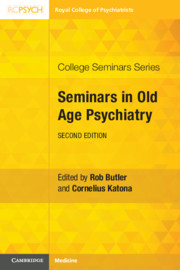Book contents
- Seminars in Old Age Psychiatry
- College Seminars Series
- Seminars in Old Age Psychiatry
- Copyright page
- Contents
- Contributors
- Preface
- Note
- Chapter 1 Healthy Ageing
- Chapter 2 Clinical Assessment
- Chapter 3 Cognitive Assessment
- Chapter 4 Imaging
- Chapter 5 Delirium
- Chapter 6 Alzheimer’s Disease
- Chapter 7 Vascular Dementia
- Chapter 8 Dementia with Lewy Bodies
- Chapter 9 Frontotemporal Dementia
- Chapter 10 Depression
- Chapter 11 Bipolar Disorder
- Chapter 12 Psychosis
- Chapter 13 Anxiety Disorders
- Chapter 14 Drug and Alcohol Misuse
- Chapter 15 Attention Deficit Hyperactivity Disorder
- Chapter 16 Medications
- Chapter 17 Electroconvulsive Therapy and Neurostimulation
- Chapter 18 Psychological Therapies
- Chapter 19 Role of an Old Age Psychiatrist
- Chapter 20 Consultation-Liaison
- Chapter 21 Palliative Care
- Chapter 22 Care Homes
- Chapter 23 Carers
- Chapter 24 Law, Capacity and Ethics
- Chapter 25 Migrants, Refugees and Asylum Seekers
- Chapter 26 Clinical Scenarios
- Index
- References
Chapter 25 - Migrants, Refugees and Asylum Seekers
Published online by Cambridge University Press: 21 June 2019
- Seminars in Old Age Psychiatry
- College Seminars Series
- Seminars in Old Age Psychiatry
- Copyright page
- Contents
- Contributors
- Preface
- Note
- Chapter 1 Healthy Ageing
- Chapter 2 Clinical Assessment
- Chapter 3 Cognitive Assessment
- Chapter 4 Imaging
- Chapter 5 Delirium
- Chapter 6 Alzheimer’s Disease
- Chapter 7 Vascular Dementia
- Chapter 8 Dementia with Lewy Bodies
- Chapter 9 Frontotemporal Dementia
- Chapter 10 Depression
- Chapter 11 Bipolar Disorder
- Chapter 12 Psychosis
- Chapter 13 Anxiety Disorders
- Chapter 14 Drug and Alcohol Misuse
- Chapter 15 Attention Deficit Hyperactivity Disorder
- Chapter 16 Medications
- Chapter 17 Electroconvulsive Therapy and Neurostimulation
- Chapter 18 Psychological Therapies
- Chapter 19 Role of an Old Age Psychiatrist
- Chapter 20 Consultation-Liaison
- Chapter 21 Palliative Care
- Chapter 22 Care Homes
- Chapter 23 Carers
- Chapter 24 Law, Capacity and Ethics
- Chapter 25 Migrants, Refugees and Asylum Seekers
- Chapter 26 Clinical Scenarios
- Index
- References
Summary
The world has the largest number of refugees and asylum seekers living outside their country of origin due to wars, political upheavals, violence and various other causes than there have been at any time since World War II. This crisis has an impact on all services in countries that are hosting refugees. Most research has focused on the needs of younger refugees and women and has neglected to study older individuals and their particular vulnerabilities.
- Type
- Chapter
- Information
- Seminars in Old Age Psychiatry , pp. 281 - 290Publisher: Cambridge University PressPrint publication year: 2019

